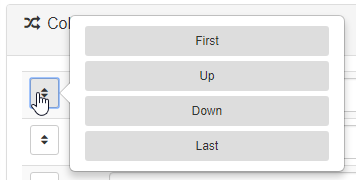Edit Job Export Options
After you create the initial job export, you can optionally configure additional settings in the Edit Export screen. Configure these additional settings before you click Run. You can also edit the Job Export at any time by clicking on the export name in the Export Configurations screen.
General
A unique name for the Job Export template.
Select either a detailed report, or a summary report.
To receive an email notification when the task is run, enable this option.
Destination Settings
Click Edit to review all Destination settings. Click Save after making any changes.
Choose the type of file that will be created on export. Select one of String Delimited, Fixed Width or XML.
The type you choose determines the remaining options that will be available for selection. All options are described below.
Indicates the end of line marker from the following: No Delimiter, Custom Delimiter (enter the character(s), CR Only (Macintosh), LF Only (Unix), CR and LF (Windows).
-
Download – Downloads the file to the specified Downloads folder on the local computer.
- Email – You can attach the export file to an email message. If you choose this option, 'From', 'To', 'Subject', and 'Message' fields also appear.
- Network Folder – If you select this option, you can then type the Network folder path in the Folder field that appears.
- FTP Upload – Requires the FTP URL, username and password.
- Web Upload – Requires the web URL, username and password.
Data Filter
Filters set when populating the job list prior to the export (either from search criteria or from an export configuration). Click Edit to change the filters.
- User/Group – Type the first few characters of the user's name or group name to locate matches. Click on a match to select it as search criteria. The search will locate matches if any of the characters you type match anywhere in the User name or group name.
- Printer/Group – Type the first few characters of the printer name or printer group name to locate matches. Click on a match to select it as search criteria. The search will locate matches if any of the characters you type match anywhere in the printer name or printer group name.
- Date Printed – Search based on a time criteria, including Any time, Today, Yesterday, This Week, Last Week, This Month, Last Month, This Quarter, Last Quarter, This Year, Last Year, and a Custom date range. If you choose Custom, you can select the YY-MM-DD to YY-MM-DD range in the fields that appear.
- Custom Fields – If you created custom fields, you can start typing characters that are defined as values within the custom field. Matches are located and listed. Click a match to select it.
Data Format
Indicate the number of decimal places to include in the export.
Enter the characters to remove from the data, separated by a comma.
Specifies how the date format appears in the export.
Specifies how the time will be formatted in the export.
Column Mappings
Click Change to view the column options and add or remove columns.
To dictate the order of columns in the exported file, click on the Order button beside a column. You can choose First, Last, Up or Down to change the order of the column's appearance.

Per column, select None, Ascending or Descending to change the sort order within the column.
Click Remove to remove a column entirely.
Click in the Add a New Column field to choose a new column to add. There are approximately 30 additional columns to choose from. You can select either 'Add Standard Column' or 'Add Static Column'. A Static column is a blank entry that can be added to the export.
When finished making changes to the columns, click Save.
Schedule
Set a schedule to re-run this Job Export using these configured settings at a specified/repeated date and time. For example, you may choose to re-run this export once per month and you can set up a monthly schedule to perform the run automatically. Click Create to set up a task that will re-run this export.
Enter a unique name for the scheduled task.
To run the task the next time the schedule settings are met, ensure the task is Enabled.
Select the frequency from the Repeat list: Daily, Weekly, Monthly, Yearly or Hourly. Also select the accompanying days, time, day, or month based on your choice of repeat frequency.
Click Create to finalize the schedule. The new scheduled task appears on the Scheduled Tasks screen, and you can view the Next Run column to determine when the task will run next.

History
The History provides at-a-glance information about the runs. Click Details to view additional information, including access to Download the export if you chose Download as the Destination for the export. To remove a run from History, click Delete.
